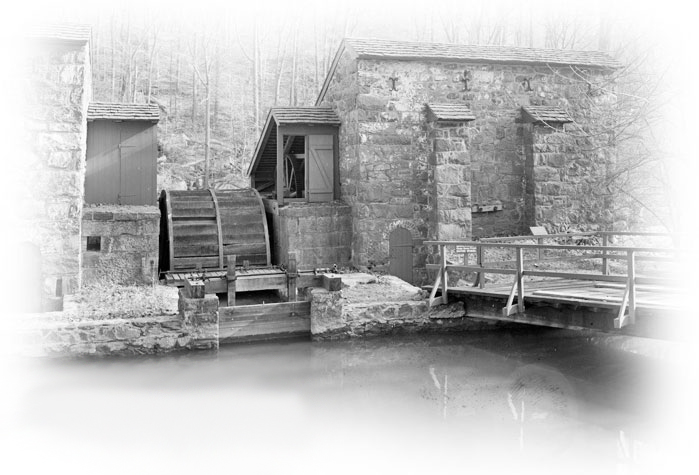#221 Brandywine River Powder Mills
1803-1921
Largest U.S. maker of explosive black powder, a once-important and now-obsolete 19th-century technology
Founded by Eleuthère Irénéé du Pont (1771-1834), the Brandywine River Mills became the largest maker of explosive black powder in the United States. That success resulted directly from the firm's pioneering use of gunpowder processing machinery driven by water wheels and water turbines. Divided into separate buildings to promote safety, its rolling, graining, and glazing mills produced black powder in a range of grades for military, sporting, hunting, construction, mining, and other applications.
From age 16 to 20, Eleuthère Irénéé du Pont had assisted Antoine Lavoisier, chief of the French gunpowder works at Essone (and founder of modern chemistry). After the du Pont family immigrated to the United States from France in 1800. Du Pont immediately put his expertise to work, upon seeing the power quality of American gunpowder used for hunting guns and pistols.
In 1802 he sited and began building the mill along the Brandywine River near Wilmington. In 1803 the mill refined its first saltpeter, and du Pont notified family-friend President Thomas Jefferson and soon received Army contracts for refining saltpeter, followed by substantial orders for gunpowder. Brandywine River Powder Mills produced its first gunpowder in 1803.
The Brandywine complex, with its various stages of production housed in separate buildings—stamping mills, rolling mills, grain mills, glaze mills, machine shops, power house, etc.—were built by machinists and millwrights, the precursors of mechanical engineers. Horse-drawn narrow-gage railways provided in-process transport between facilities. In later years, steam engines drove conveyor belts that moved materials along the production lines. The mechanical operations—rotating wheels, turbines, vessels and vats, distillation and combustion processes, etc.—are examples of fledgling mechanical engineering principles. Du Pont instituted management practices that established safety practices and ensured high-quality production. The largest powder mills of the time, these mills were unique in that they refined the raw material and made everything they used, making gunpowder to any specification.
Improvements and expansions were made by successive generations of du Ponts including Alfred Victor (1798-1856) and Henry (1838-1926). Lammot du Pont (1831-1884), however, was trained as an engineer and made several significant developments both to the mechanical process and to the chemistry in mid-19th century. Lammot du Pont improved black powder, which forced other mechanical changes in the process and lead the company into the new field of high explosives. In 1857 Lammot patented "B" blasting powder—also known as soda powder—which used inexpensive Peruvian and Chilean sodium nitrate and made DuPont a major force in the blasting powder industry. The B blasting powder greatly improved the expansion economics (not appropriate for military or sporting uses). Lammot built new plants for the production of smokeless gunpowder and dynamite.
Started as a large-scale, sophisticated manufactory, Brandywine maintained operations for 119 years. The Brandywine River Powder Mills performed shell loading and some smokeless nitrations during World War I. They were the most sophisticated producers of black power until their close in 1921. This is an obsolete technology today. Aside from one operating powder mill, the Hagley Museum owns the only virtually complete set of process equipment in North America.
The Eleutherian Mills–Hagley Foundation was formed in the 1950s, with the Hagley Museum and Library formed in 1957.

Landmark Location
Hagley Museum and Library
Wilmington, Delaware
Visiting Info
Regular hours;
limited hours from January to March,
closed Thanksgiving and Christmas days
302-658-2400
Directions
Entrance off Route 141, 7 miles north of Interstate 95
Ceremony Notes
Ceremony took place Oct. 9, 2002, with Past President John R. Parker presenting the bronze landmark plaque.
Plaque location
In hydraulic power plant on museum site.
